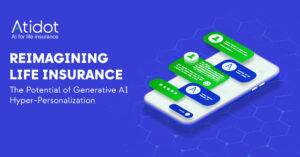Incorporating generative AI in the life insurance industry can be done through several key applications:
- Customer Experience Enhancement: Use generative AI to create virtual agents or chatbots that can interact with customers, answer their queries, and provide personalized assistance throughout the insurance journey. These virtual agents can simulate human-like conversations and offer a seamless and efficient customer service experience.
- Personalized Policy Recommendations: Leveraging generative AI, insurance providers can develop sophisticated recommendation engines. By analyzing a customer’s unique circumstances and preferences, the system can generate tailor-made policy options that align with their specific needs and financial capacities.
- Product Development and Innovation: Generative AI can assist in developing new insurance products by simulating scenarios and assessing potential risks and benefits. This helps insurers stay competitive by offering innovative policies that cater to emerging customer demands.
- Automated Claims Processing:
By using generative AI, life insurance companies can automate claims processing, reducing the need for manual intervention. This expedites the claims settlement process, leading to faster payouts for beneficiaries and policyholders. - Natural Language Processing (NLP): Integrating NLP capabilities through generative AI allows insurers to extract valuable insights from unstructured data sources like medical reports, customer feedback, and social media, improving the accuracy of risk assessment and decision-making.
- Personalized Marketing and Sales: Generative AI can analyze customer data and generate targeted marketing content and offers. This allows insurance companies to engage customers with personalized campaigns, increasing conversion rates and customer retention.
- Life Expectancy Estimation: Generative AI can analyze various factors like medical history, lifestyle, and socio-economic data to estimate a person’s life expectancy. This information aids insurers in customizing policies based on individual life expectancies.
- Fraud Detection and Prevention: Generative AI algorithms can learn patterns from historical fraud cases and generate predictive models to identify potentially fraudulent claims. This helps insurers detect and prevent fraudulent activities more effectively, saving resources and ensuring fair premiums for genuine policyholders.
- Risk Assessment and Underwriting: Generative AI can analyze vast amounts of data, including medical records, lifestyle information, and historical insurance claims, to assess an individual’s risk profile accurately. By generating predictive models, insurers can make more informed decisions about coverage options and pricing.
While incorporating generative AI in life insurance can yield significant benefits, it’s crucial to ensure compliance with data privacy regulations and maintain transparency in how AI algorithms impact policy pricing and customer interactions. Regular monitoring and auditing of AI systems are also essential to mitigate potential biases and ensure ethical practices in the insurance industry.



 min read
min read 
 min read
min read

 min read
min read



